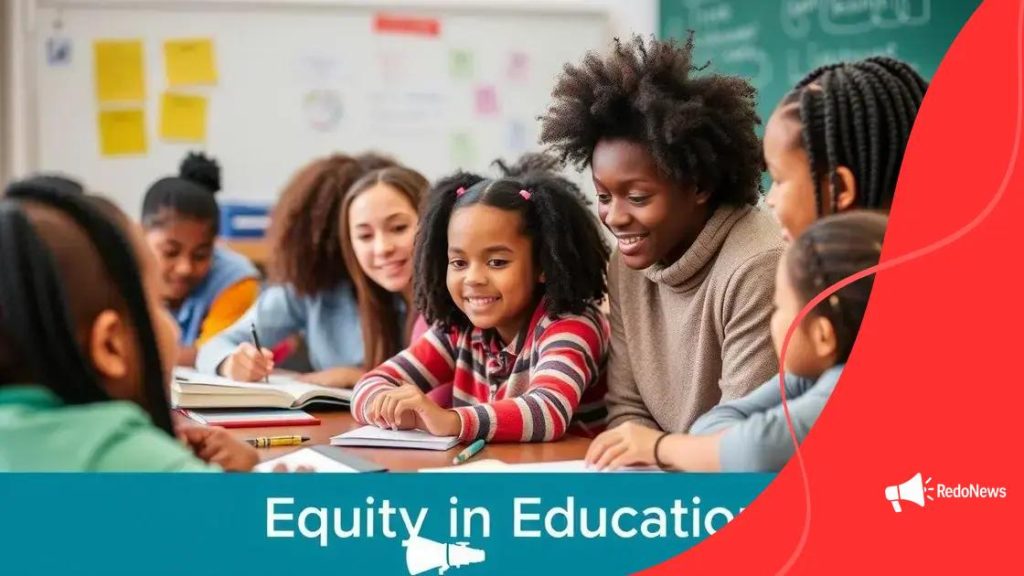Education equity initiatives advance opportunities for all

Education equity initiatives aim to provide all students with equal access to quality education and resources, addressing disparities through technology, community engagement, and mental health support.
Education equity initiatives advance the conversation around fairness in education. These efforts aim to level the playing field for all students, no matter their background. Have you ever considered how these initiatives impact your community?
Understanding education equity initiatives
Understanding education equity initiatives is crucial for creating a fair educational environment. Education equity means ensuring that all students receive the support they need to succeed, regardless of their backgrounds. This involves addressing various barriers that may hinder access to quality education.
What are education equity initiatives?
Education equity initiatives are programs and policies designed to promote fairness in education. They aim to remove obstacles that prevent students from achieving their full potential. Involvement from communities, schools, and policymakers is essential for these initiatives to be effective.
Key components of successful initiatives
- Access to resources: Making learning materials, technology, and support services available to all students.
- Inclusive teaching practices: Adapting teaching methods to meet diverse learning needs.
- Community engagement: Involving parents and local organizations in educational processes.
- Regular assessments: Measuring progress and making adjustments as needed to support student success.
These components work together to create an environment where every student can thrive. For instance, schools that adopt inclusive practices often notice an improvement in student engagement and performance.
Engaging the community is another fundamental aspect of these initiatives. When parents and local organizations collaborate with schools, the benefits can be significant. This partnership fosters a sense of belonging and encouragement among students, creating a support network that enhances their educational journey.
Moreover, regular assessments ensure that educational strategies remain effective. By collecting data and feedback, schools can adapt to the changing needs of students, which is vital for maintaining education equity.
Key benefits of equitable education
The key benefits of equitable education are significant and transformative. When all students receive the support they need, it leads to not just individual success, but also stronger communities. Equitable education creates an environment where every learner can thrive, regardless of their background.
Improved academic performance
One of the most noticeable benefits of equitable education is improved academic performance. When students have access to the same resources and opportunities, their chances of success increase significantly. This equal access helps close achievement gaps and raises the overall educational standards.
Greater social cohesion
Education equity fosters a sense of belonging among students from different backgrounds. When diverse learners are educated together, it helps build social connections and understanding. This unity can lead to more inclusive communities.
Long-term economic advantages
- Higher earnings potential: Students who benefit from equitable education often go on to earn higher salaries.
- Reduced poverty rates: By ensuring that all students succeed, we can help break the cycle of poverty.
- Stronger workforce: A well-educated population contributes to a more competitive economy.
Moreover, equitable education practices have long-term economic advantages. By investing in every student’s success, communities can reduce poverty rates and create a stronger workforce. Equity in education not only benefits individuals but lifts entire communities.
Furthermore, when schools prioritize equity, they create a positive learning environment. Students feel valued and motivated to reach their potential. This mental and emotional support translates to better performance and engagement in school.
In summary, equitable education brings numerous advantages to all involved. It helps improve academic success, fosters social cohesion, and provides lasting economic benefits.
Challenges facing education equity

Challenges facing education equity are significant and must be addressed to ensure that every student has the opportunity to succeed. Despite the progress made, many barriers still exist that hinder equitable access to education. Understanding these challenges is crucial for creating more effective solutions.
Funding disparities
One major challenge is the disparity in school funding. Schools in wealthier areas often have access to better resources, while those in low-income areas struggle. This lack of funding leads to inadequate facilities, outdated materials, and fewer extracurricular opportunities.
Access to quality teachers
Another challenge is the uneven distribution of qualified teachers. Schools in disadvantaged areas frequently have a shortage of experienced educators, which impacts the quality of education students receive. Teacher turnover rates are also often higher in these schools, disrupting student learning.
Social and cultural barriers
- Language barriers: Students from non-English-speaking backgrounds may struggle to understand lessons.
- Social stigma: Students from underprivileged backgrounds may face discrimination or low expectations.
- Family support: Some families may not have the resources or knowledge to support their children’s education effectively.
These social and cultural barriers can affect a student’s confidence and ability to engage in learning. When students feel unsupported, it can lead to lower motivation and academic performance.
Additionally, systemic issues within the education system can perpetuate these challenges. Policies that do not prioritize equity can further widen the gap between privileged and underprivileged students. Creating change requires collaboration among educators, policymakers, and communities to address these deep-rooted problems.
By recognizing the various challenges facing education equity, we can begin to formulate strategies to overcome them. Only through persistent effort can we work toward an educational landscape where every student has an equal chance to thrive.
Successful examples of initiatives worldwide
Successful examples of initiatives worldwide showcase how education equity can be achieved through innovative approaches. Many countries are making strides to ensure that every student has access to quality education, regardless of their background. These initiatives highlight the impact that targeted efforts can have.
Finland’s Education System
In Finland, the education system is often cited as a model for equity. The country offers free education for all, including higher education. Teachers are highly respected and well-trained, which contributes to the overall success of the system. Additionally, Finland emphasizes equal access to resources, ensuring that no student is left behind.
Canada’s Indigenous Education Programs
Canada has implemented several initiatives aimed at improving education for Indigenous students. These programs focus on cultural relevance and community involvement. By incorporating traditional knowledge and practices into the curriculum, schools create an engaging environment for Indigenous learners.
South Africa’s No Fee Schools
- No Fee Schools: Many public schools in South Africa have become “No Fee” schools, allowing students from low-income families to attend without financial barriers.
- Scholarship Programs: Numerous scholarship programs support underprivileged students in accessing quality secondary and tertiary education.
- Community Involvement: Local communities play a crucial role, often providing additional resources and support to enhance education.
These successful examples demonstrate that tailored educational initiatives can lead to significant changes. By focusing on inclusivity and resource availability, these countries have made substantial progress in promoting education equity.
Moreover, collaboration between governments, communities, and educational institutions is essential for the sustainability of these initiatives. Sharing best practices and lessons learned can foster further improvements in education systems globally.
As we look at these examples, it becomes clear that with commitment and innovative approaches, education equity is within reach in many parts of the world.
The future of education equity initiatives
The future of education equity initiatives looks promising as more stakeholders recognize the importance of fair learning opportunities. With increasing awareness, innovative solutions are emerging to tackle existing challenges in the educational landscape. These initiatives aim to create a more inclusive environment for all students.
Technological advancements
Technology plays a crucial role in advancing education equity. Educational technologies can bridge gaps by providing resources to underserved communities. Platforms that offer free online courses and interactive learning tools can significantly enhance access for students who may not have traditional resources.
Focus on mental health
Addressing mental health is also becoming a priority within education equity initiatives. Schools are recognizing that a supportive environment is vital for student success. Programs that provide counseling and mental health resources help create a safe space for students, encouraging them to engage and thrive.
Community engagement and advocacy
- Local partnerships: Schools are increasingly forming partnerships with local organizations, which can provide additional resources and support.
- Advocacy efforts: Grassroots movements are working to promote policies that focus on education equity.
- Inclusive curriculum development: Engaging diverse voices in curriculum design ensures that all students see their experiences reflected in what they learn.
These strategies not only enhance the educational experience but also foster a sense of belonging among students. By involving communities in the educational process, schools can better understand and respond to the unique needs of their students.
Furthermore, data-driven approaches are becoming more common. Collecting and analyzing data helps educators identify gaps and develop targeted interventions. This method allows for more personalized learning experiences that cater to individual needs.
As we look forward, the ongoing commitment to education equity will be crucial for the development of future generations. By embracing technology, focusing on mental health, and fostering community engagement, we can continue to build a more equitable education system.
The commitment to education equity is vital for shaping a brighter future for all students. By understanding the challenges and recognizing successful initiatives, we can foster inclusive environments where everyone has the opportunity to thrive. Technological advancements, community engagement, and mental health support are all crucial components of this journey. As we move forward, it’s essential to keep pushing for policies and practices that ensure education equity remains a priority. Together, we can create a world where every student can achieve their full potential.
FAQ – Questions About Education Equity Initiatives
What are education equity initiatives?
Education equity initiatives are programs aimed at ensuring all students have access to the same quality of education and resources, regardless of their background.
Why is technology important for education equity?
Technology enhances access to educational resources, enabling students from underserved communities to benefit from online learning and support.
How do community partnerships help in education equity?
Community partnerships bring additional resources, support, and engagement, helping schools to better meet the diverse needs of their students.
What role does mental health support play in education equity?
Mental health support is crucial as it creates a safe and supportive environment that encourages students to thrive academically and personally.
